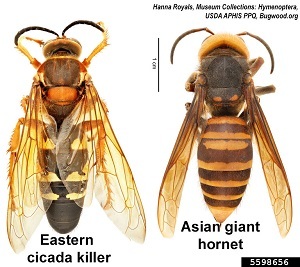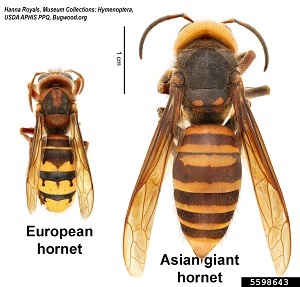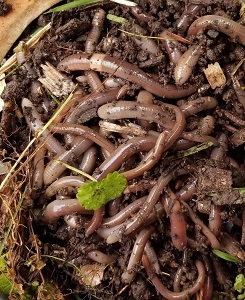This Month's Topics:- Fall Wasp and Hornet Identification
- Report Invasive Jumping Worms
- Upcoming Learning Opportunities
Fall Wasp and Hornet IdentificationGood news, backyard entomologists! That big yellow-and-black insect you found is probably not an Asian giant hornet, AKA, "murder hornet". Asian giant hornets are a potential invasive species in the Western United States, but they have not been found in New York and are unlikely to make their way here any time soon. The Asian giant hornet has many lookalike species, but some of the most common are the eastern cicada killer and the European hornet.  The eastern cicada killer can be identified by its large, red eyes and its reddish thorax. They may be large, but they are virtually no danger to humans as they prefer to use their stingers solely on cicadas. Only the females sting, and they will only sting humans if handled roughly. Cicada killers dig nests in open areas, often with many nests in the same area. The females use their stingers to hunt and paralyze cicadas, dragging them into their nest for their young (larvae) to feed on. The eastern cicada killer can be identified by its large, red eyes and its reddish thorax. They may be large, but they are virtually no danger to humans as they prefer to use their stingers solely on cicadas. Only the females sting, and they will only sting humans if handled roughly. Cicada killers dig nests in open areas, often with many nests in the same area. The females use their stingers to hunt and paralyze cicadas, dragging them into their nest for their young (larvae) to feed on.
 The European hornet has distinctive “teardrop” like markings on its abdomen and is roughly half the size of an Asian giant hornet. They live in colonies usually upwards of 300 workers, and may aggressively defend their nests. If you have a nuisance European hornet nest near your home, always use professional pest control services. The European hornet has distinctive “teardrop” like markings on its abdomen and is roughly half the size of an Asian giant hornet. They live in colonies usually upwards of 300 workers, and may aggressively defend their nests. If you have a nuisance European hornet nest near your home, always use professional pest control services.
If you think you have found an Asian giant hornet in NY, please review identification materials on the NYS Department of Agriculture and Markets website. If you still have suspicions after review, you can email photos and location information to Plants@agriculture.ny.gov.
Report Invasive Jumping WormsAttention, fall gardeners! While earthworms are usually a welcome sight in your garden, not all earthworms are alike. Jumping worms, sometimes known as “crazy worms”, are an invasive species native to Asia that are being found increasingly in many parts of New York State. Jumping worms primarily stay in the top layer of soil, leaching nutrients and turning topsoil into a texture similar to coffee grounds. This makes it difficult for many plants to grow, including garden plants, trees, and lawns. You can tell the difference between a jumping worm and a less destructive European earthworm by examining the worm’s collar (clitellum). Jumping worms have a collar that is milky-white, relatively close to the head and flush with their bodies.  Here's how you can help prevent the spread of jumping worms: Here's how you can help prevent the spread of jumping worms:
- Know the signs: Look for dark soil that looks like coffee grounds. Jumping worms have a milky-white smooth collar, close to their heads.
- Play. Clean. Go: Check your soil, compost, tools, boots, and plant roots. Clean everything of worms and egg casings before transporting.
- Be worm-wise: When purchasing soil, compost, plants (even trees) or worms for bait, check for jumping worms or egg casings to prevent jumping worms from invading your yard.
- Report: If you find a jumping worm, take a picture and report the sighting to www.nyimapinvasives.org.
Check out the Homeowner's Guide for Asian Jumping Worms from the NY Invasive Species Research Institute for more information. Need help identifying a worm, insect, or plant disease? Email a photo and description to DEC at foresthealth@dec.ny.gov. Photo by Heather Dockstader via iMapInvasives
Upcoming Learning OpportunitiesBackyard Invasives: Identification, Control, and Management Tips to Prepare Your Property for Fall (Adirondack Park Invasive Plant Program) (virtual event) —Thursday, September 30 at 10 a.m. - This workshop will provide attendees with the knowledge needed to carry out safe chemical and manual control of invasive species following the principles of integrated pest management (IPM). Learn some tips and tricks to reduce the impact of invasive species before winter's arrival in the Adirondacks and to help you get the most out of your lawn and garden come spring. If the timing of this webinar does not fit your schedule, recordings will be available via APIPP's YouTube channel following the event. Please RSVP to receive the link to the webinar and/or to be notified when the video is posted online. Walk and Talk at Beaver Meadow Audubon Center (Wyoming County) (Western NY PRISM) (in-person event) - Saturday, October 2 from 10 a.m. to 11:30 a.m. - WNY PRISM Education and Outreach Program Manager Cecilia Pershyn will discuss the invasive species found at the nature center. Online registration is required. Spotted Lanternfly Teacher Training (Finger Lakes PRISM) (virtual event) - Tuesday, October 5 from 4 p.m. to 5:30 p.m. - Interested in invasive species and learning how to integrate this topic into your classroom curricula or program? This free workshop is for you! Learn how you and your students can be part of "early detection" for spotted lanternfly in the Finger Lakes and beyond. Educators participating in this workshop receive free spotted lanternfly maker kits for their class and 1.5 hours of CTLE credits. Best for grades K-5. Register online. Invasive Removal at Harriman State Park (Orange County) (Lower Hudson PRISM) (in-person event) - Sunday, October 17 from 10 a.m. to 12 p.m. - Help protect birds, butterflies, and wildflowers by removing invasive plants with the Invasive Strike Force Crew. Learn more online and sign up online before the event. #decinvasivespecies#fineartmagazine#artofliving |  The
The The
The Here's how you can help prevent the spread of jumping worms:
Here's how you can help prevent the spread of jumping worms:
No comments:
Post a Comment
Note: Only a member of this blog may post a comment.